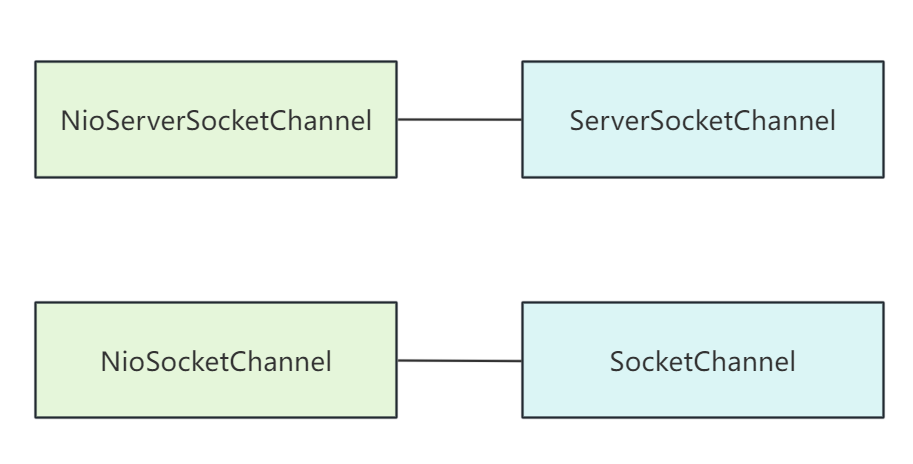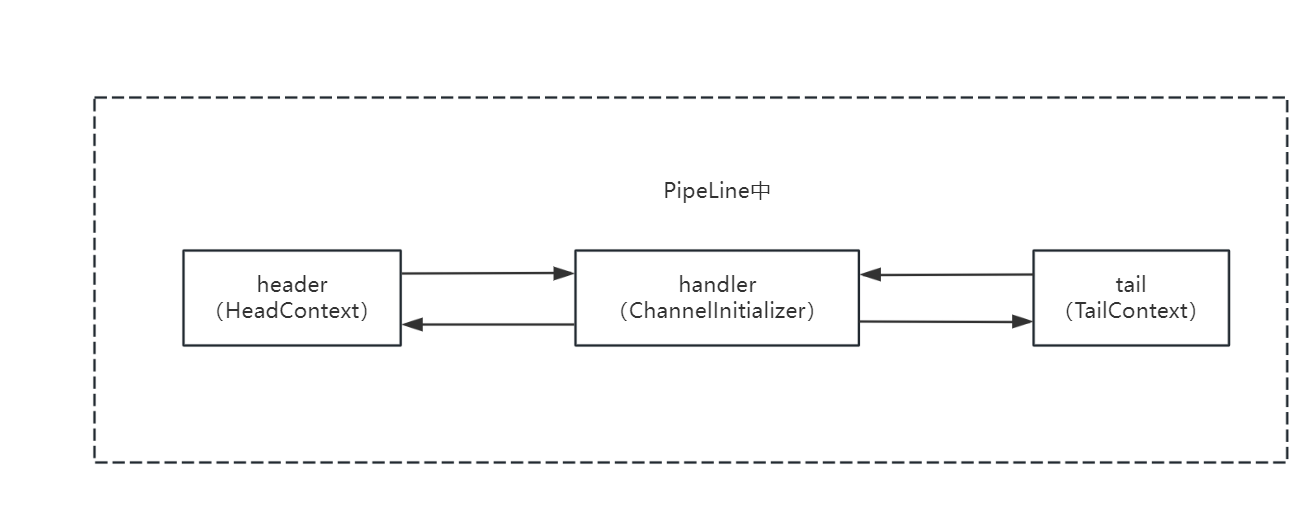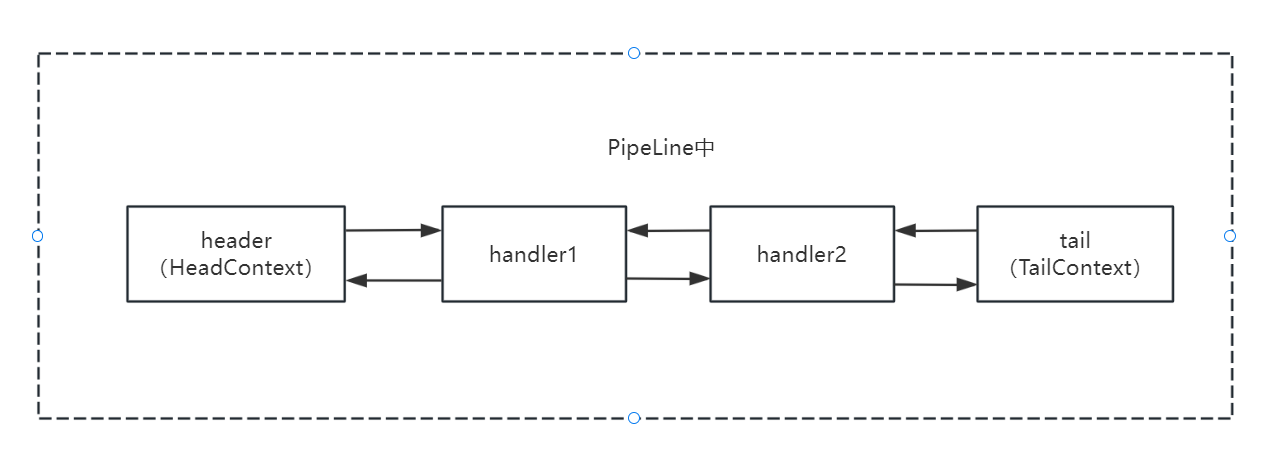源码用到的最多的特性就是多态,一个基础类可能有2到3层继承关系,甚至可能更多,所以在看的时候要弄清楚当前这个变量究竟是哪一个类,是子类还是父类,也有可能是内部类,这样每个地方所执行的代码逻辑就比较清晰了。
1. 网络操作抽象类 Channel
Channel是Netty对网络操作的抽象类,通过Channel可以进行I/O操作。客户端成功连接,服务端会创建一个Channel与客户端进行绑定。
比较常用的Channel接口实现类有:
- NioServerSocketChannel用于服务端
- NioSocketChannel用于客户端
这两个实现类在底层与JDK的ServerSocketChannel,SocketChannel相对应,是一对一的关系,是对JDK中的再次包装。

客户端和服务端在启动的过程中会调用channel方法:
服务端:
public class Server {
public static void main(String[] args) {
EventLoopGroup bossGroup = new NioEventLoopGroup();
EventLoopGroup workGroup = new NioEventLoopGroup();
try {
ServerBootstrap serverBootstrap = new ServerBootstrap();
serverBootstrap.group(bossGroup, workGroup)
.channel(NioServerSocketChannel.class)
.option(ChannelOption.SO_BACKLOG, 100)
.handler(new LoggingHandler(LogLevel.INFO))
.childHandler(new ChannelInitializer<SocketChannel>() {
@Override
protected void initChannel(SocketChannel socketChannel) throws Exception {
ChannelPipeline cp = socketChannel.pipeline();
cp.addLast(new LoggingHandler(LogLevel.INFO));
}
});
Channel serverChannel = serverBootstrap.bind().sync().channel();
serverChannel.closeFuture().sync();
} catch (Exception e) {
System.out.println(e.getMessage());
}
}
}
客户端:
public class Client {
public static void main(String[] args) {
EventLoopGroup group = new NioEventLoopGroup();
try {
Bootstrap bootstrap = new Bootstrap();
bootstrap.group(group)
.channel(NioSocketChannel.class)
.option(ChannelOption.TCP_NODELAY, true)
.handler(new ChannelInitializer<SocketChannel>() {
@Override
protected void initChannel(SocketChannel socketChannel) throws Exception {
ChannelPipeline cp = socketChannel.pipeline();
cp.addLast(new LoggingHandler(LogLevel.INFO));
}
});
Channel clientChannel = bootstrap.connect().sync().channel();
clientChannel.closeFuture().sync();
} catch (Exception e) {
System.out.println(e.getMessage());
}
}
}
对于客户端中,首先实例化了netty中的任务线程池EventLoopGroup,像它的类名称一样,事件循环组,用来执行一组指定任务。接下来就是实例化netty的核心启动类BootStrap(服务端是ServerBootStrap),并向其中注册事件循环器,channel,handler,childHandler。
下面分析客户端整个启动过程是怎样的。
首先看.channel()方法,它的参数是NioSocketChannel.class,我们点进去这个方法可以看到:
public B channel(Class<? extends C> channelClass) {
return channelFactory(new ReflectiveChannelFactory<C>(
ObjectUtil.checkNotNull(channelClass, "channelClass")
));
}
这里创建了一个工厂类ReflectiveChannelFactory,并将channelClass传递进去,点击进去查看这个工厂类的构造方法:
private final Constructor<? extends T> constructor;
public ReflectiveChannelFactory(Class<? extends T> clazz) {
ObjectUtil.checkNotNull(clazz, "clazz");
try {
this.constructor = clazz.getConstructor();
} catch (NoSuchMethodException e) {
throw new IllegalArgumentException("Class " + StringUtil.simpleClassName(clazz) +
" does not have a public non-arg constructor", e);
}
}
这里通过放射获取到传入的channelClass的空参构造方法,并赋值给了自己的成员变量constructor,到这里传递进去的NioSocketChannel.class并没有被创建,仅仅是获取到了它的无参构造方法,那什么被实例化呢?可以继续看到ReflectiveChannelFactory中有一个方法newChannel()方法。代码如下:
@Override
public T newChannel() {
try {
return constructor.newInstance();
} catch (Throwable t) {
throw new ChannelException("Unable to create Channel from class " + constructor.getDeclaringClass(), t);
}
}
这里通过newInstantce()反射创建了传递进去的NioSocketChannel实例,那么肯定有地方调用了这个方法,我们继续向下看。
接着将一些变量和handler赋值给了bootstrap的成员变量,下面调用了.connect()方法进行连接服务端的一系列操作,这里是重点,涉及到整个客户端启动过程都干了什么事情。
进入connect()方法,看到源码:
public ChannelFuture connect() {
validate();
SocketAddress remoteAddress = this.remoteAddress;
if (remoteAddress == null) {
throw new IllegalStateException("remoteAddress not set");
}
return doResolveAndConnect(remoteAddress, config.localAddress());
}
这里的validate()方法是检查事件循环器和channel工厂是否创建,继续进入doResolveAndConnect()方法中看:
private ChannelFuture doResolveAndConnect(final SocketAddress remoteAddress, final SocketAddress localAddress) {
// 这一步很关键
final ChannelFuture regFuture = initAndRegister();
final Channel channel = regFuture.channel();
if (regFuture.isDone()) {
if (!regFuture.isSuccess()) {
return regFuture;
}
return doResolveAndConnect0(channel, remoteAddress, localAddress, channel.newPromise());
} else {
// Registration future is almost always fulfilled already, but just in case it's not.
final PendingRegistrationPromise promise = new PendingRegistrationPromise(channel);
regFuture.addListener(new ChannelFutureListener() {
@Override
public void operationComplete(ChannelFuture future) throws Exception {
// Directly obtain the cause and do a null check so we only need one volatile read in case of a
// failure.
Throwable cause = future.cause();
if (cause != null) {
// Registration on the EventLoop failed so fail the ChannelPromise directly to not cause an
// IllegalStateException once we try to access the EventLoop of the Channel.
promise.setFailure(cause);
} else {
// Registration was successful, so set the correct executor to use.
// See https://github.com/netty/netty/issues/2586
promise.registered();
doResolveAndConnect0(channel, remoteAddress, localAddress, promise);
}
}
});
return promise;
}
}
进入第一行代码的initAndRegister()方法,看看都干了什么:
final ChannelFuture initAndRegister() {
Channel channel = null;
try {
channel = channelFactory.newChannel();
init(channel);
} catch (Throwable t) {
if (channel != null) {
// channel can be null if newChannel crashed (eg SocketException("too many open files"))
channel.unsafe().closeForcibly();
// as the Channel is not registered yet we need to force the usage of the GlobalEventExecutor
return new DefaultChannelPromise(channel, GlobalEventExecutor.INSTANCE).setFailure(t);
}
// as the Channel is not registered yet we need to force the usage of the GlobalEventExecutor
return new DefaultChannelPromise(new FailedChannel(), GlobalEventExecutor.INSTANCE).setFailure(t);
}
ChannelFuture regFuture = config().group().register(channel);
if (regFuture.cause() != null) {
if (channel.isRegistered()) {
channel.close();
} else {
channel.unsafe().closeForcibly();
}
}
// If we are here and the promise is not failed, it's one of the following cases:
// 1) If we attempted registration from the event loop, the registration has been completed at this point.
// i.e. It's safe to attempt bind() or connect() now because the channel has been registered.
// 2) If we attempted registration from the other thread, the registration request has been successfully
// added to the event loop's task queue for later execution.
// i.e. It's safe to attempt bind() or connect() now:
// because bind() or connect() will be executed *after* the scheduled registration task is executed
// because register(), bind(), and connect() are all bound to the same thread.
return regFuture;
}
哦,我们可以看到这行代码 channel = channelFactory.newChannel()`这里调用了newChannel方法进行实例化NioSocketChannel,我们知道这个方法是通过调用NioSocketChannel的无参构造方法进行创建的,那么NioSocketChannel的无参构造方法都做了什么?我们先跳到这里看一下:
我们一路从NioSocketChannel的无参构造方法点进去,最终进去了它的父类的父类AbstractChannel的构造方法:
protected AbstractChannel(Channel parent) {
this.parent = parent;
id = newId();
unsafe = newUnsafe();
pipeline = newChannelPipeline();
}
这里为channel生成了一个新的id,实例化了UnSafe实例,创建了一个管道pipeline ,管道是netty处理事件传播的核心。newChannelPipeline方法在管道里面生成了一个head和一个tail,分别对应的是DefaultChannelPipeline的两个内部类HeadContext,TailContext,这两个类在后续事件传播处理上起到关键作用。创建并生成了一个双向链表的结构,此时管道中是这样的:

除了这三件事,在构造方法的调用过程中还实例化了底层SocketChannel(NioSocketChannel实例化之前、实例化了内部的 NioSocketChannelConfig 实例,它用于保存 channel 的配置信息、还设置了 SocketChannel 的非阻塞模式,代码如下:
public NioSocketChannel(SelectorProvider provider, InternetProtocolFamily family) {
this(newChannel(provider, family));//调用本身的newChannel方法
}
private static SocketChannel newChannel(SelectorProvider provider, InternetProtocolFamily family) {
try {
// 实例化socketChannel
SocketChannel channel = SelectorProviderUtil.newChannel(OPEN_SOCKET_CHANNEL_WITH_FAMILY, provider, family);
return channel == null ? provider.openSocketChannel() : channel;
} catch (IOException e) {
throw new ChannelException("Failed to open a socket.", e);
}
}
public NioSocketChannel(Channel parent, SocketChannel socket) {
super(parent, socket);
// 初始化配置信息,保存socket,channel作为成员变量
config = new NioSocketChannelConfig(this, socket.socket());
}
protected AbstractNioChannel(Channel parent, SelectableChannel ch, int readInterestOp) {
super(parent);
this.ch = ch;
this.readInterestOp = readInterestOp;
try {
// 设置为非阻塞模式
ch.configureBlocking(false);
} catch (IOException e) {
try {
ch.close();
} catch (IOException e2) {
logger.warn(
"Failed to close a partially initialized socket.", e2);
}
throw new ChannelException("Failed to enter non-blocking mode.", e);
}
}
OK,这些大致就是NioSocketChannel初始化干的一些事情。现在回去initAndRegister方法继续向下看。
下面调用了init(channel);方法,进入这个方法,看看做了什么事情,这里调用的是AbstractBootstrap的子类Bootstrap 的init方法毕竟一开始new的是BootStrap(多态)。
@Override
void init(Channel channel) {
ChannelPipeline p = channel.pipeline();
p.addLast(config.handler());
setChannelOptions(channel, newOptionsArray(), logger);
setAttributes(channel, newAttributesArray());
}
这里首先获取到NioSocketChannel初始化时创建的pipeline,然后调用config中的handler()方法。这里调用的handler方法获取到的是哪一个handler呢?我们进入handler()这个方法中可以看到时调用的BootstrapConfig的父类AbstractBootstrap的hander()方法:
public final ChannelHandler handler() {
return bootstrap.handler();
}
可以看出这里时调用的bootStrap的handler方法,我们看一下bootstrap的handler方法:
final ChannelHandler handler() {
return handler;
}
这里的hander就是第一开始创建bootstrap时传入的handler
bootstrap.group(group)
.channel(NioSocketChannel.class)
.option(ChannelOption.TCP_NODELAY, true)
// 这里赋值的handler
.handler(new ChannelInitializer<SocketChannel>() {
@Override
protected void initChannel(SocketChannel socketChannel) throws Exception {
ChannelPipeline cp = socketChannel.pipeline();
cp.addLast(new LoggingHandler(LogLevel.INFO));
}
});
//对应的hander方法
public B handler(ChannelHandler handler) {
this.handler = (ChannelHandler)ObjectUtil.checkNotNull(handler, "handler");
return this.self();
}
由此可见config.handler()这里返回的是ChannelInitializer。所以在init方法中pipeline加入的是ChannelInitializer。此时的pipeline:

至于它为什么在中间,感兴趣的可以从addLast方法一路点下去看pipleline的addLast0方法,这里贴出代码就不做说明了。从这里也可以看出实际pipeline每次在add的时候添加的都是一个将channel包装后的context,而不是channel本身。实际后面说的pipeline中的hander也是说的AbstractChannelHandlerContext 。
private void addLast0(AbstractChannelHandlerContext newCtx) {
AbstractChannelHandlerContext prev = tail.prev;
newCtx.prev = prev;
newCtx.next = tail;
prev.next = newCtx;
tail.prev = newCtx;
}
至此init方法结束,下面到:
ChannelFuture regFuture = config().group().register(channel);
config().group()这里是拿到配置,然后调用group方法,group方法是调用bootstrap.group()方法获取第一开始注册进bootstrap中的事件循环器组NioEventLoopGroup然后调用它的register(channel)方法,这个方法是在它的父类MultithreadEventLoopGroup 中:
@Override
public ChannelFuture register(Channel channel) {
return next().register(channel);
}
next()方法:
@Override
public EventLoop next() {
return (EventLoop) super.next();
}
// super.next()
@Override
public EventExecutor next() {
return chooser.next();
}
这里chooser.next()是从children EventExecutor数组中取得一个EventExecutor,然后调用它的register方法。chooser是MultithreadEventExecutorGroup类的一个成员属性,是在MultithreadEventExecutorGroup初始化的时候创建的,那么什么地方会触发MultithreadEventExecutorGroup它的初始化?这个类的一个子类我们很熟悉,就是一开始new的NioEventLoopGroup,那我们就可以从NioEventLoopGroup的空参构造方法一直向下点看看做了什么。一路点下去可以看到这么一大段代码:
protected MultithreadEventExecutorGroup(int nThreads, Executor executor,
EventExecutorChooserFactory chooserFactory, Object... args) {
checkPositive(nThreads, "nThreads");
if (executor == null) {
executor = new ThreadPerTaskExecutor(newDefaultThreadFactory());
}
// 创建了一个
children = new EventExecutor[nThreads];
for (int i = 0; i < nThreads; i ++) {
boolean success = false;
try {
// 重点看这里,给children数组赋值!!!
children[i] = newChild(executor, args);
success = true;
} catch (Exception e) {
// TODO: Think about if this is a good exception type
throw new IllegalStateException("failed to create a child event loop", e);
} finally {
if (!success) {
for (int j = 0; j < i; j ++) {
children[j].shutdownGracefully();
}
for (int j = 0; j < i; j ++) {
EventExecutor e = children[j];
try {
while (!e.isTerminated()) {
e.awaitTermination(Integer.MAX_VALUE, TimeUnit.SECONDS);
}
} catch (InterruptedException interrupted) {
// Let the caller handle the interruption.
Thread.currentThread().interrupt();
break;
}
}
}
}
}
// 通过工厂创建chooser
chooser = chooserFactory.newChooser(children);
// 。。。。。。。。。
}
重点看一下给children数组赋值的这行代码:
children[i] = newChild(executor, args);
这个newChild方法:
protected abstract EventExecutor newChild(Executor executor, Object... args) throws Exception;
我们在main函数中创建的是NioEventLoopGroup,而它重写了父类MultithreadEventExecutorGroup的newChild方法,所以这里调用的是NioEventLoopGroup的newChild方法:
@Override
protected EventLoop newChild(Executor executor, Object... args) throws Exception {
SelectorProvider selectorProvider = (SelectorProvider) args[0];
SelectStrategyFactory selectStrategyFactory = (SelectStrategyFactory) args[1];
RejectedExecutionHandler rejectedExecutionHandler = (RejectedExecutionHandler) args[2];
EventLoopTaskQueueFactory taskQueueFactory = null;
EventLoopTaskQueueFactory tailTaskQueueFactory = null;
int argsLength = args.length;
if (argsLength > 3) {
taskQueueFactory = (EventLoopTaskQueueFactory) args[3];
}
if (argsLength > 4) {
tailTaskQueueFactory = (EventLoopTaskQueueFactory) args[4];
}
return new NioEventLoop(this, executor, selectorProvider,
selectStrategyFactory.newSelectStrategy(),
rejectedExecutionHandler, taskQueueFactory, tailTaskQueueFactory);
}
我们可以看到最后返回的是NioEventLoop,所以这里最终调用的是NioEventLoop的register(channel)方法(long long的多态),而register(channel)又是在NioEventLoop的父类SingleThreadEventLoop中。
@Override
public ChannelFuture register(Channel channel) {
return register(new DefaultChannelPromise(channel, this));
}
// 继续向下调用的register方法:
@Override
public ChannelFuture register(final ChannelPromise promise) {
ObjectUtil.checkNotNull(promise, "promise");
promise.channel().unsafe().register(this, promise);
return promise;
}
这里先创建了一个promise,然后将channel和eventLoop赋值进去,后面从promise中拿出channel获取到channel中的unsafe实例(NioSocketChannelUnsafe),调用它的register方法(将eventLoop和promise注册):
@Override
public final void register(EventLoop eventLoop, final ChannelPromise promise) {
ObjectUtil.checkNotNull(eventLoop, "eventLoop");
if (isRegistered()) {
promise.setFailure(new IllegalStateException("registered to an event loop already"));
return;
}
if (!isCompatible(eventLoop)) {
promise.setFailure(
new IllegalStateException("incompatible event loop type: " + eventLoop.getClass().getName()));
return;
}
AbstractChannel.this.eventLoop = eventLoop;
if (eventLoop.inEventLoop()) {
register0(promise);
} else {
try {
eventLoop.execute(new Runnable() {
@Override
public void run() {
register0(promise);
}
});
} catch (Throwable t) {
logger.warn(
"Force-closing a channel whose registration task was not accepted by an event loop: {}",
AbstractChannel.this, t);
closeForcibly();
closeFuture.setClosed();
safeSetFailure(promise, t);
}
}
}
对于我们前面过来的 register 操作,其实提交到 eventLoop 以后,就直接返回 promise 实例了,剩下的 register0 是异步操作,它由 NioEventLoop 实例来完成。
继续看一下register0方法:
private void register0(ChannelPromise promise) {
try {
// check if the channel is still open as it could be closed in the mean time when the register
// call was outside of the eventLoop
if (!promise.setUncancellable() || !ensureOpen(promise)) {
return;
}
boolean firstRegistration = neverRegistered;
doRegister();
neverRegistered = false;
registered = true;
// Ensure we call handlerAdded(...) before we actually notify the promise. This is needed as the
// user may already fire events through the pipeline in the ChannelFutureListener.
pipeline.invokeHandlerAddedIfNeeded();
safeSetSuccess(promise);
pipeline.fireChannelRegistered();
// Only fire a channelActive if the channel has never been registered. This prevents firing
// multiple channel actives if the channel is deregistered and re-registered.
if (isActive()) {
if (firstRegistration) {
pipeline.fireChannelActive();
} else if (config().isAutoRead()) {
// This channel was registered before and autoRead() is set. This means we need to begin read
// again so that we process inbound data.
//
// See https://github.com/netty/netty/issues/4805
beginRead();
}
}
} catch (Throwable t) {
// Close the channel directly to avoid FD leak.
closeForcibly();
closeFuture.setClosed();
safeSetFailure(promise, t);
}
}
doRegister();方法:
@Override
protected void doRegister() throws Exception {
boolean selected = false;
for (;;) {
try {
selectionKey = javaChannel().register(eventLoop().unwrappedSelector(), 0, this);
return;
} catch (CancelledKeyException e) {
//.....
}
}
}
我们可以看到,这里做了 JDK 底层的 register 操作,将 SocketChannel(或 ServerSocketChannel) 注册到 Selector 中,并且可以看到,这里的监听集合设置为了 0,也就是什么都不监听。肯定在某个地方进行了修改否则什么也做不了。
执行到这里:
pipeline.invokeHandlerAddedIfNeeded();
到这里也就意味着就算是 registered (registered = true)了,这里会将 ChannelInitializer 内部添加的 handlers 添加到 pipeline 中。一路点下去会发现这里最终调用的是ChannelInitializer 的handlerAdded方法:
@Override
public void handlerAdded(ChannelHandlerContext ctx) throws Exception {
if (ctx.channel().isRegistered()) {
// This should always be true with our current DefaultChannelPipeline implementation.
// The good thing about calling initChannel(...) in handlerAdded(...) is that there will be no ordering
// surprises if a ChannelInitializer will add another ChannelInitializer. This is as all handlers
// will be added in the expected order.
if (initChannel(ctx)) {
// We are done with init the Channel, removing the initializer now.
removeState(ctx);
}
}
}
这里会调用initChannel方法也就是main函数中:
.handler(new ChannelInitializer<SocketChannel>() {
@Override
protected void initChannel(SocketChannel socketChannel) throws Exception {
ChannelPipeline cp = socketChannel.pipeline();
cp.addLast(new LoggingHandler(LogLevel.INFO));
}
});
我们这里的initChannel方法,这里会将ChannelInitializer中的hander加入到pipeline中。
private boolean initChannel(ChannelHandlerContext ctx) throws Exception {
if (initMap.add(ctx)) { // Guard against re-entrance.
try {
// 自定义的initChannel方法
initChannel((C) ctx.channel());
} catch (Throwable cause) {
exceptionCaught(ctx, cause);
} finally {
// 将ChannelInitializer从pipeline中删除。
if (!ctx.isRemoved()) {
ctx.pipeline().remove(this);
}
}
return true;
}
return false;
}
我们前面也说过,ChannelInitializer 的 initChannel(channel) 被执行以后,那么其内部添加的 handlers 会进入到 pipeline 中,然后上面的 finally 块中将 ChannelInitializer 的实例从 pipeline 中删除,那么此时 pipeline 就算建立起来了,此时的pipeline:

我们继续向下看:
pipeline.fireChannelRegistered();
这里是pipeline中事件传播的重要地方。fireXXX,
@Override
public final ChannelPipeline fireChannelRegistered() {
AbstractChannelHandlerContext.invokeChannelRegistered(head);
return this;
}
从header开始向后执行,继续看invokeChannelRegistered的代码:
static void invokeChannelRegistered(final AbstractChannelHandlerContext next) {
EventExecutor executor = next.executor();
if (executor.inEventLoop()) {
next.invokeChannelRegistered();
} else {
executor.execute(new Runnable() {
@Override
public void run() {
next.invokeChannelRegistered();
}
});
}
}
继续看调用的invokeChannelRegistered方法:
private void invokeChannelRegistered() {
if (invokeHandler()) {
try {
((ChannelInboundHandler) handler()).channelRegistered(this);
} catch (Throwable t) {
invokeExceptionCaught(t);
}
} else {
fireChannelRegistered();
}
}
这里调用了hander方法,那这里是获取的哪里的hander呢?这里的参数head是AbstractChannelHandlerContext类,它是DefaultChannelPipeline的一个内部类,pipeLine在一开始NioSocketChannel在初始化的过程中通过newChannelPipeline 进行了实例化,最终调用的是DefaultChannelPipeline的构造方法:
protected DefaultChannelPipeline(Channel channel) {
this.channel = ObjectUtil.checkNotNull(channel, "channel");
succeededFuture = new SucceededChannelFuture(channel, null);
voidPromise = new VoidChannelPromise(channel, true);
tail = new TailContext(this);
head = new HeadContext(this);
head.next = tail;
tail.prev = head;
}
这里初始化的是TailContext和HeadContext是AbstractChannelHandlerContext的子类,他又对用的hander方法那么handler方法肯定是获取pipeline中加入的hander,那么pipeline是怎么把hander加入进去的呢?看一下addLast(hander)方法:
@Override
public final ChannelPipeline addLast(EventExecutorGroup group, String name, ChannelHandler handler) {
final AbstractChannelHandlerContext newCtx;
synchronized (this) {
checkMultiplicity(handler);
// 这行代码
newCtx = newContext(group, filterName(name, handler), handler);
addLast0(newCtx);
// If the registered is false it means that the channel was not registered on an eventLoop yet.
// In this case we add the context to the pipeline and add a task that will call
// ChannelHandler.handlerAdded(...) once the channel is registered.
if (!registered) {
newCtx.setAddPending();
callHandlerCallbackLater(newCtx, true);
return this;
}
EventExecutor executor = newCtx.executor();
if (!executor.inEventLoop()) {
callHandlerAddedInEventLoop(newCtx, executor);
return this;
}
}
callHandlerAdded0(newCtx);
return this;
}
// 对应代码
private AbstractChannelHandlerContext newContext(EventExecutorGroup group, String name, ChannelHandler handler) {
return new DefaultChannelHandlerContext(this, childExecutor(group), name, handler);
}
这里每加入一个hander实际上是添加一个DefaultChannelHandlerContext(hander被context包装)
final class DefaultChannelHandlerContext extends AbstractChannelHandlerContext {
private final ChannelHandler handler;
DefaultChannelHandlerContext(
DefaultChannelPipeline pipeline, EventExecutor executor, String name, ChannelHandler handler) {
super(pipeline, executor, name, handler.getClass());
this.handler = handler;
}
@Override
public ChannelHandler handler() {
return handler;
}
}
实际上addLast(hander)最后将hander赋值给了context的成员变量,哦哦,所以handler()方法返回的是addLast方法传入的handler,然后这行代码:
((ChannelInboundHandler) handler()).channelRegistered(this);
调用了传入handler的channelRegistered方法。看一下我们传入的LoggingHandler 的channelRegistered方法:
public void channelRegistered(ChannelHandlerContext ctx) throws Exception {
if (this.logger.isEnabled(this.internalLevel)) {
this.logger.log(this.internalLevel, this.format(ctx, "REGISTERED"));
}
ctx.fireChannelRegistered();
}
继续 ctx.fireChannelRegistered();
@Override
public ChannelHandlerContext fireChannelRegistered() {
invokeChannelRegistered(findContextInbound(MASK_CHANNEL_REGISTERED));
return this;
}
这里会继续向下找其他的inbound hander,重复上面的过程。
其他fireXXX也是差不多的原理。
OK,到这里register完毕了,回到initRegister方法了,继续后面的代码:
if (regFuture.cause() != null) {
if (channel.isRegistered()) {
channel.close();
} else {
channel.unsafe().closeForcibly();
}
}
return regFuture;
我们要知道,不管是服务端的 NioServerSocketChannel 还是客户端的 NioSocketChannel,在 bind 或 connect 时,都会先进入 initAndRegister 这个方法,所以我们上面说的那些,对于两者都是通用的。
大家要记住,register 操作是非常重要的,要知道这一步大概做了哪些事情,register 操作以后,将进入到 bind 或 connect 操作中。
后续的connect操作也是pipeline的head中,通过unsafe实例,修改selector为connect事件完成的,会从tail开始调用每一个outbound handler的connect方法。可以从doResolveAndConnect0向下点,这里就不把全部代码贴出来了。
@Override
public ChannelFuture connect(SocketAddress remoteAddress, ChannelPromise promise) {
// 实际调用pipleline的connect方法
return pipeline.connect(remoteAddress, promise);
}
@Override
public final ChannelFuture connect(SocketAddress remoteAddress, ChannelPromise promise) {
// 从tail开始调用
return tail.connect(remoteAddress, promise);
}
@Override
public ChannelFuture connect(
final SocketAddress remoteAddress, final SocketAddress localAddress, final ChannelPromise promise) {
ObjectUtil.checkNotNull(remoteAddress, "remoteAddress");
if (isNotValidPromise(promise, false)) {
// cancelled
return promise;
}
// 从tail开始寻找outbound的handler
final AbstractChannelHandlerContext next = findContextOutbound(MASK_CONNECT);
EventExecutor executor = next.executor();
if (executor.inEventLoop()) {
// 执行每一个outbound hander的connect方法
next.invokeConnect(remoteAddress, localAddress, promise);
} else {
safeExecute(executor, new Runnable() {
@Override
public void run() {
next.invokeConnect(remoteAddress, localAddress, promise);
}
}, promise, null, false);
}
return promise;
}
2. 自问问题
- 怎么知道一个handler是inbound handler还是outbound handler?
- 为什么子类的中要调用父类的fireXXX方法?
- inbound是从pipeline的头部处理还是尾部处理?





















 5万+
5万+

 被折叠的 条评论
为什么被折叠?
被折叠的 条评论
为什么被折叠?








